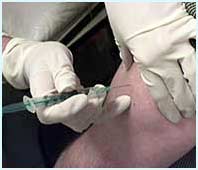Drug shock and precautions
All types of drugs can cause shock but frequency and severity often increase in order: oral medicine - intramuscular - intravenous - infusion. Need to choose the form of drugs with less risk of shock and milder level.
When the body is not suitable for the active ingredient or other ingredients in the drug (collectively referred to as
 The right technique can limit anaphylaxis from happening (Photo: whyfiles.org) medicine) can be shocking. So, any person, taking any medicine must be alert. In hospitals, nurses must be present in the patient's room, directly give medicines to patients, promptly handle incidents; Avoid giving medicine to patients who use it on their own, especially to avoid white-handed contracts for home-keepers.
The right technique can limit anaphylaxis from happening (Photo: whyfiles.org) medicine) can be shocking. So, any person, taking any medicine must be alert. In hospitals, nurses must be present in the patient's room, directly give medicines to patients, promptly handle incidents; Avoid giving medicine to patients who use it on their own, especially to avoid white-handed contracts for home-keepers.
Drug shock is more common with people who may be weak (young children, the elderly, people with other illnesses). With this object, it is necessary to consider the benefits and risks, choose the safest way of use, if because of illness, it is necessary to use high-frequency drugs to be more cautious.
Quality reduction drugs : expired or very short shelf life (only 1/3, 1/4 term used on the label), there are unusual signs compared to the original drug (broken edge, easy broken, wet, discolored, opaque, heterogeneous, unusual flavors .). In this case, the drug has metamorphosed easily. If any of these factors are not used (regardless of the form of the drug).
For some high-frequency shock medicines (such as penicillin injections .), it is mandatory to test the reaction before use. The usual technique is to subcutaneously inject a very small amount of medication (10 UI), after a certain period of time, if there is no abnormal phenomenon such as erythema . then you can continue taking the medicine as prescribed.
Techniques for improper use of drugs are also shocking, especially when taking infusion drugs. Some of the following incorrect medication techniques need to be overcome:
- Do not mix the drug into solution or emulsion: for example, do not shake artesunate completely in 5% glucose solution, do not shake well to have homogeneous hydrocortison emulsion before injection.
- High-speed transmission: occurs due to non-compliance with the order or not tracking so that the speed adjustment key is shifted during transmission.
- Transmission with a lot, fast. For example, the injection of acyclovir with the usual dose is quite safe, but when the infusion is rapid, high doses are likely to occur in shock. In the cold season, when rapid infusion and large quantities of low concentration solutions, energy (such as 5% glucose .) is also shocking (it should be incubated warmly, initially transmitted at a slow speed, for patients who prefer Gradually, then transfer at the specified speed).
- Transmission of overdose: occurs when using a large infusion bottle (such as lactate ringer usually plays up to 1-2 liters), infusing to young children, not monitoring and stopping the infusion when the dose is sufficient.
- Transmission of air bubbles into the vessels: occurs by shaking the bottle at the time of suspension, do not let the first droplets flow out to expel air bubbles before the fluid is transferred to the body.
- Some transmission conditions have not reached the sterile requirements: tool tray, pincers, scissors, clamps . are not sterilized; Do not check the term of using the set and the bag.
- No preparation or regular check of the necessary medical facilities to handle shock, embarrassing when needed; Monitoring is not close, shock is heavy to know, slow processing; Lack of calm: sometimes mild shock (chilling just need to keep warm, check and use cardiovascular medicine if necessary), then quickly transfer the sick person to the higher level, bad means of transport (heavy vehicles, many potholes) makes shock worse.
In order to limit drug-induced shock, at the grassroots level, it is recommended to use the form of drug in the list of essential drugs, if it is shock, it is usually mild to treat; Avoid using drugs over the route, with a high frequency of shock beyond the ability to solve.
Some cases of shock occur with the responsibility of the medical staff, but there are many cases of shock that still occur that cannot be saved because the patient does not adapt to the drug or may be too poor. There should be an objective view before the drug shock, resolving the situation, and reaching a reasonable point.
Thuy Phuong
- How to provide first aid to people who have drug shock
- What is Narcan that can save Demi Lovato right in the hands of death due to drug shock?
- The elixir 'revived' the person who died from drug shock
- Tips for dealing with
- Thermal shock: Danger of life when riding in a sunny car
- First aid when electrocuted
- How to handle thermal shock in cars
- Wave of new generation of cancer treatment drugs
- What happens to the body after kicking drugs?
- America experimented with electric shock with soldiers' brains
- How to deal with drug poisoning
- Russian scientists predict that there will soon be a drug to treat cancer
 Green tea cleans teeth better than mouthwash?
Green tea cleans teeth better than mouthwash? Death kiss: This is why you should not let anyone kiss your baby's lips
Death kiss: This is why you should not let anyone kiss your baby's lips What is salmonellosis?
What is salmonellosis? Caution should be exercised when using aloe vera through eating and drinking
Caution should be exercised when using aloe vera through eating and drinking